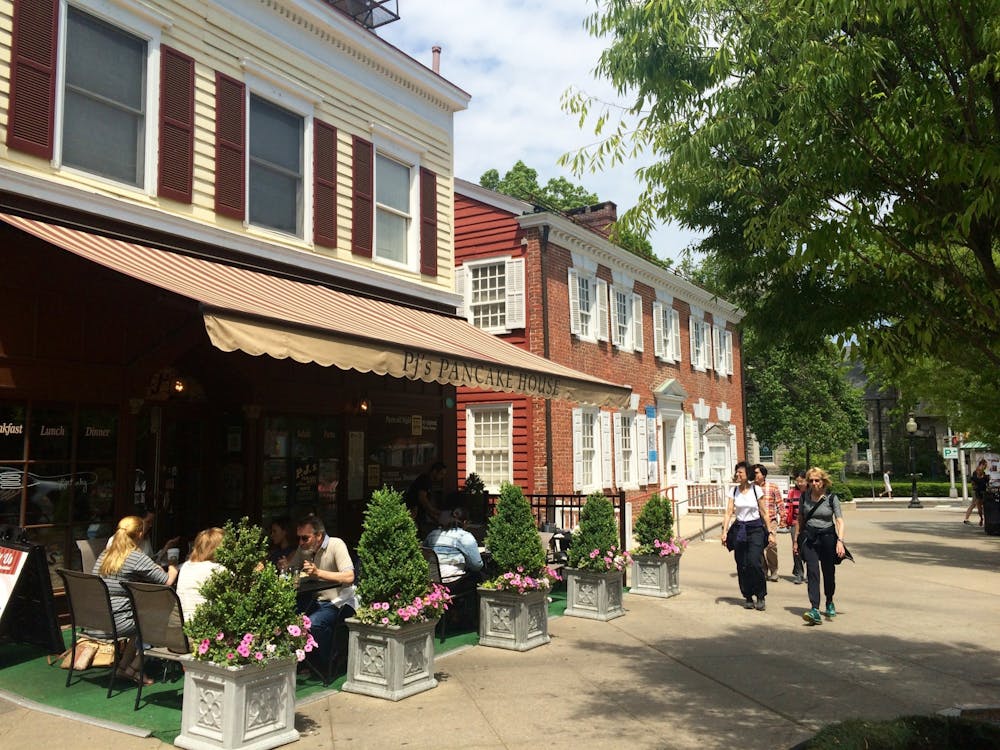At 2 p.m. on Sunday afternoon, the Frist Film and Performance Theater was alive with the sound of music. And clapping. And dance shoes. And cheering for Princeton's first international dance festival.
Princeton's classical Indian dance group, Kalaa, in conjunction with the International Center, hosted the festival in an "attempt to showcase diversity through the medium of dance, and to allow more interaction amongst the different dance and ethnic communities of Princeton," said Ananya Chakravarti '05, who organized the event.
The afternoon started with a performance by Sara Slaughter and Matt Brown, two members of a Philadelphia-based clogging team. Clogging is a form of dance halfway between tap and Irish step dancing. They danced a number called "Cute Cute," for which they were recruited to join their team.
Next, Ballet Folklorico danced to three songs: "El Son de la Negra" with Juan Gonzalez '05, and Vanessa Woods, '04, "Prince" Arts Editor, "Madrugada" with Woods, Kathleen Molnar '04 and Vanessa Gomez '05, and "El Jarabe Tapatio" with Gonzalez and Molnar. The traditional Mexican performance was colorful in attire and meaning; each number was an elaborate combination of precise footsteps, flirtatious movements and beautiful costumes.
"We jumped at the opportunity to be a part of the dance festival and display the diversity of dance and ethnic backgrounds at Princeton" Molnar said. Although the group lost three excellent dancers over the summer, its current members have been practicing — with great success — to produce a very impressive act.
Aditi Shrivastava '06 followed with a classical Indian piece, a solo performance "Kaahe Chhedo Mohe," which relates the tale of teasing between Lord Krishna and his consort Radha. Shrivastava combined soft and strong motions to convey both the reprimands and the love of Radha for her Lord. The piece was a visual treat, with the richness and fluidity of the dance and the richness of the green fabric, red hand dye and gold jewelry.
The newly restructured Black Arts Company performed "Who Wants This?" choreographed by one of the troupe's former directors, Mike Fletcher '03. The urban music and movements were a tribute to him and his contributions to the group. Many new members contributed to the dance, which still presented remarkable synchronization and unbelievable pelvis rolls.
If you have never seen Princeton Capoeira in action, you are missing an amazingly talented group, taught by Contra Mestre Zumbi. Capoeira is a Brazilian art that combines fighting, dancing, rhythm and movement. It was originally used by slaves to hide their self-defense and combat training. In action, it is a combination of break dancing, karate and aerobatics. This group performed successive feats of physical mastery to the accompaniment of dialog among its members.
A group of gumboot dancers then displayed a unique combination of footwork and boots used to create music. This technique originated in the mines of South Africa as a secret form of artistic expression. It is reminiscent of step dancing with its own rhythms and system of calls and responses.
The Chimera Project, a new addition to the campus, danced to "Rush Hour," choreographed by its founder, Lara Ionescu '06. The group plans to focus on modern dance, and this piece combined the visual appeal of individual and group movements to communicate the complexity of motion and the beauty of chaos.
In "Spirit Moves, I Move," Thema Bryant-Davis, SHARE coordinator, performed a liturgical dance, one used for worship and ministry, combining modern and West African dances. She juxtaposed stillness and slow motions with rapid gesticulations and maneuvers to communicate the beauties and hardships of African and African-American experiences.
Sympoh, Princeton's resident urban arts crew, freestyled with lots of breaking, flips, popping, hip-hop, and other dance techniques. The group threatened to force audience members to dance if they didn't cheer loudly enough, but the audience hardly needed this admonition to applaud their perfect freezes and headspins. Chris Ramos '05, the group's president, said that "Sympoh chose to participate in this weekend's event because we think that we can show the Princeton community something that they don't often get to see, learn about, or enjoy."

The hosting group, Kalaa, concluded the afternoon with a performance of Thillana. This is traditionally the final dance in any Bharatanatyam performance, and it is particularly energetic in order to convey the dancers' satisfaction in a job well done.
Kalaa hopes that this festival will become an annual tradition, a way of showcasing and enjoying local talent while spreading cultural understanding. The event benefits performers as well as observers. Says the group's Chakravarti, "We're really excited about what we hope will be the first of many such festivals at Princeton and hope that it will be a success, but at the end of the day, we just want to dance."







